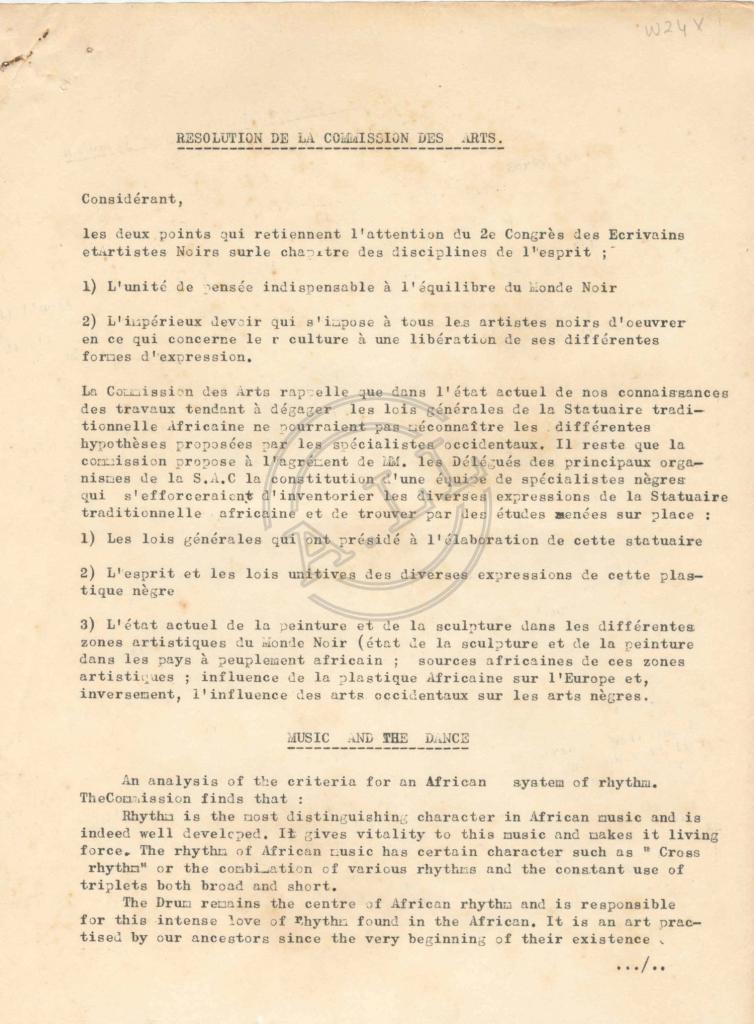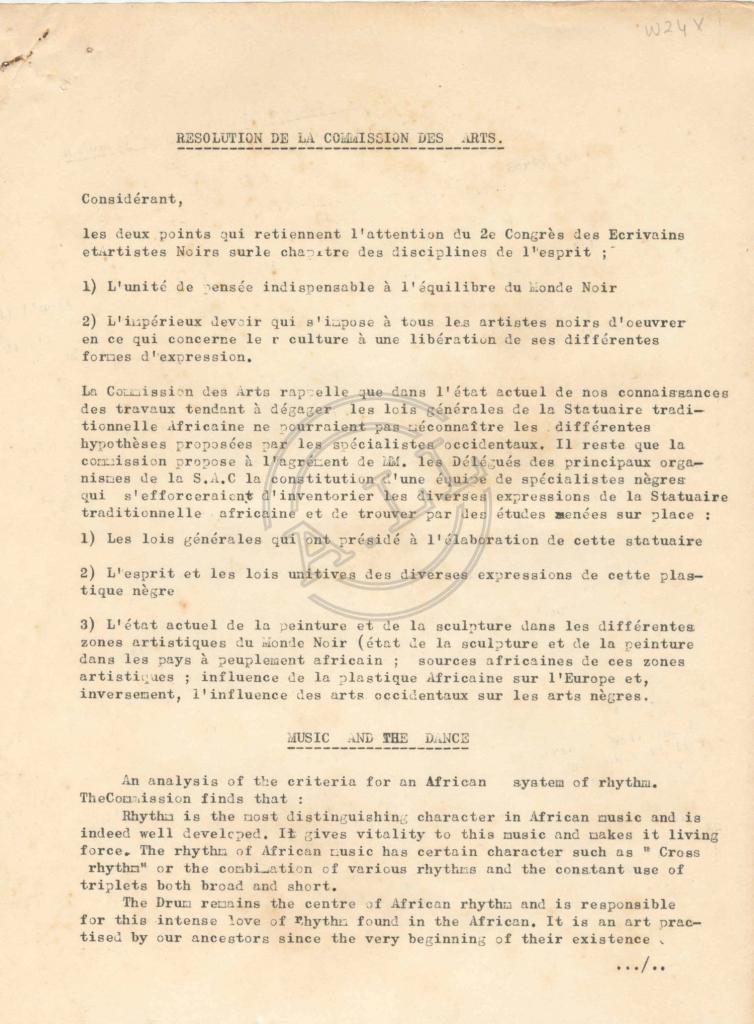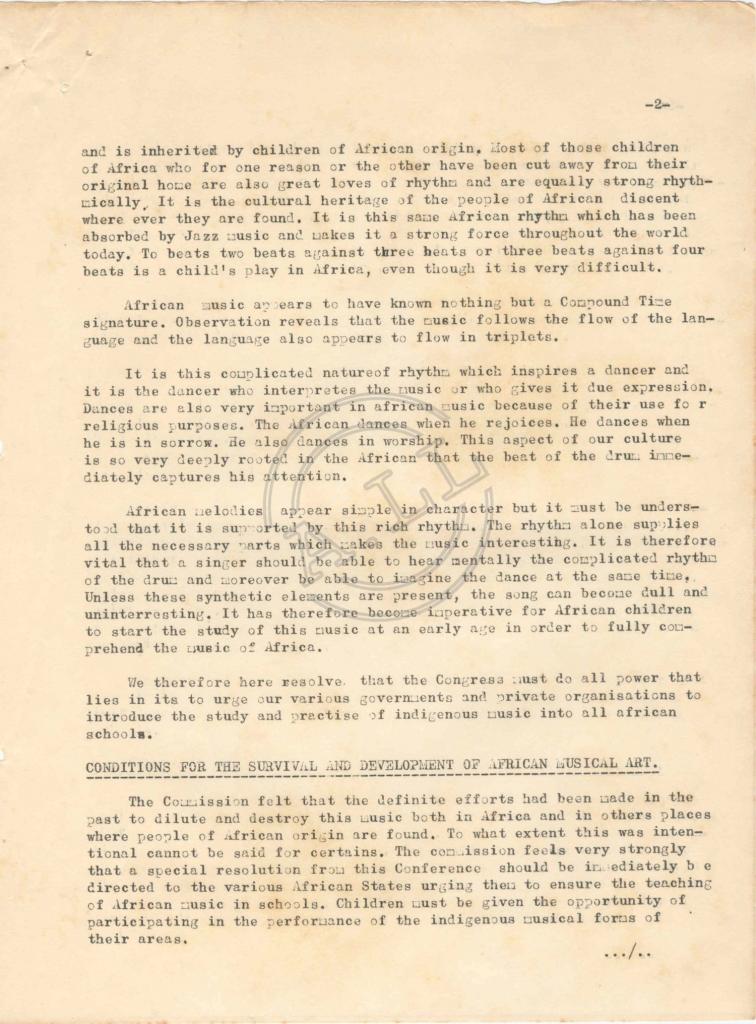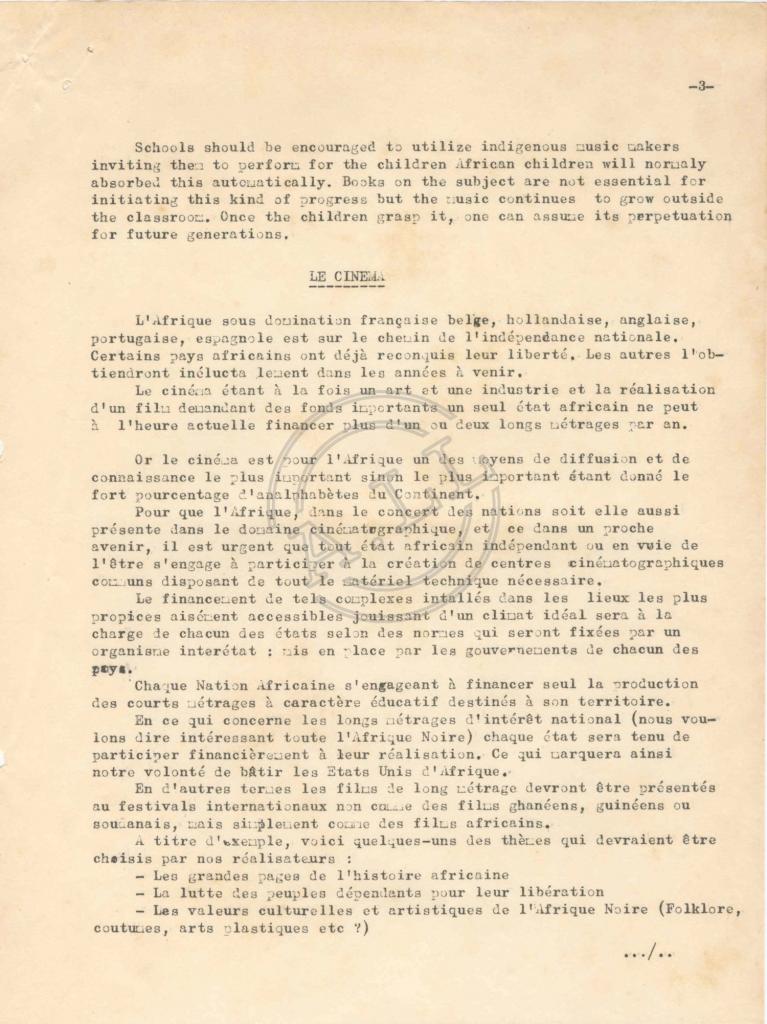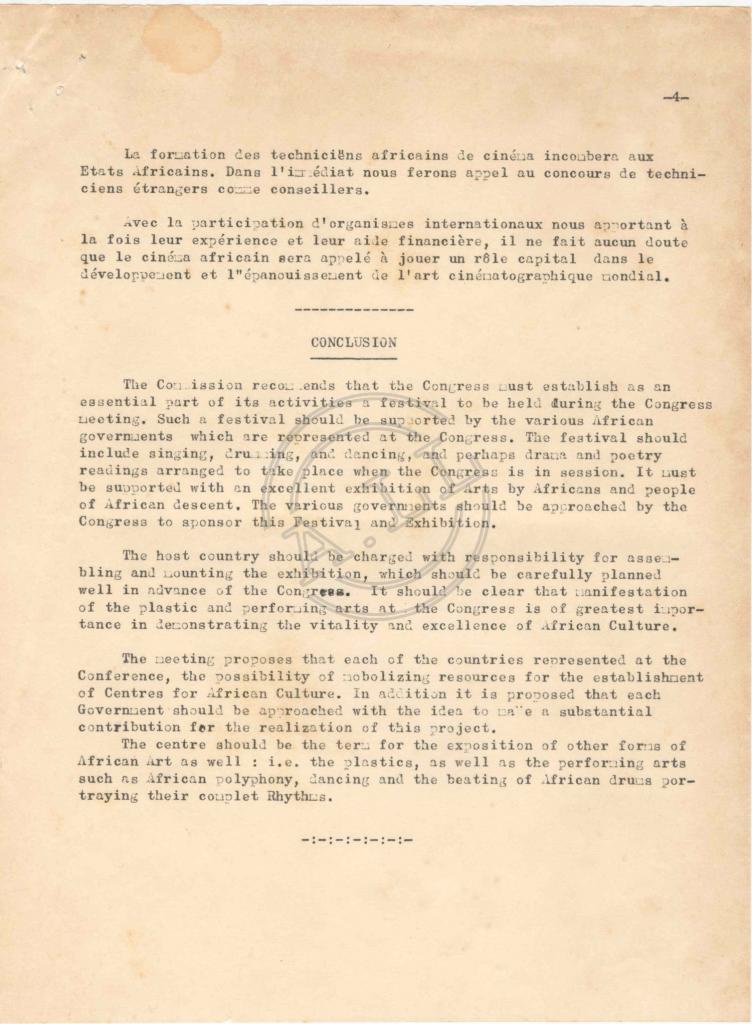Cota
0005.000.026
Tipologia
Declaração
Impressão
Policopiado
Suporte
Papel comum
Autor
Congresso de Escritores e Artistas Negros
Data
28 Mar 1959 / 1 Abr 1959
Conservação
Bom
Fundo
Imagens
4
Acesso
Público
RESOLUTION DE LA COMMISSION DES ARTS.
Considérant,
les deux points qui retiennent l’attention du 2e Congrès de Écrivains artistes Noirs sur le chapitre des disciplines de l’esprit;
1) L’unité de pensée indispensable à l’équilibre du Monde Noir
2) L’impérieux devoir qui s’impose à tous les artistes noirs d’oeuvrer en ce qui concerne le culture à une libération de ses différentes forces d’expression.
La Commission des Arts rappelle que dans l’état actuel de nos connaissances des travaux tendant à dégager les lois générales de la Statuaire traditionnelle Africaine ne pourraient pas méconnaître les différentes hypothèses proposées par les spécialistes occidentaux. Il reste que la commission propose à l’agrément de MM. les Délégués des principaux organismes de la S.A.C la constitution d’une équipe de spécialistes nègres qui s’efforceraient d’inventorier les diverses expressions de la Statuaire traditionnelle africaine et de trouver par des études menées sur place:
1) Les lois générales qui ont présidé à l’élaboration de cette statuaire
2) L’esprit et les lois unitives des diverses expressions de cette plastique nègre
3) L’état actuel de la peinture et de la sculpture dans les différentes zones artistiques du Monde Noir (état de la sculpture et de la peinture dans les pays à peuplement africain; sources africaines de ces zones artistiques; influence de la plastique Africaine sur l’Europe et, inversement, l’influence des arts occidentaux sur les arts nègres.
MUSIC AND THE DANCE
An analysis of the criteria for an African system of rhythm. The Commission finds that:
Rhythm is the most distinguishing character in Africa n music and is indeed well developed. It gives vitality to his music and makes it living force. The rhythm of African music has certain character such as “Cross rhythm” or the combination of various rhythms and the constant use of triplets both broad and short.
The Drum remains the centre of African rhythm and is responsible for this intense love of Rhythm found in the African. It is an art practised by our ancestors since the very beginning of their existence and is inherited by children of African origin. Most of those children of Africa who for one reason or the other have been cut away from their original home are also great lovers of rhythm and are equally strong rhythmically. It is the cultural heritage of the people of African descent where ever they are found. It is this same African rhythm which has been absorbed by Jazz music and makes it a strong force throughout the world today. To beats two beats against three beats or three beats against four beats is a child’s play in Africa, even though it is very difficult.
African music appears to have known nothing but a Compound Time signature. Observation reveals that the music follows the flow of the language and the language also appears to flow in triplets.
It is this complicated nature of rhythm which inspires a dancer and it is the dancer who interpretes the music or who gives it due expression. Dances are also very important in african music because of their use for religious purposes. The African dances when he rejoices. He dances when he is in sorrow. He also dances in worship. This aspect of our culture is so very deeply rooted in the African that the beat of the drum immediately captures his attention.
African melodies appear simple in character but it must be understood that it is supported by this rich rhythm. The rhythm alone supplies all the necessary parts which make the music interesting. It is therefore vital that a singer should be able to hear mentally the complicated rhythm of the drum and moreover be able imagine the dance at the same time. Unless these synthetic elements are present, the song can become dull and uninteresting. It has therefore become imperative for African children to start the study of this music at an early age in order to fully comprehend the music of Africa.
We therefore here resolve that the Congress must do all power that lies in its to urge our various governments and private organisations to introduce the study and pactise of indigenous music into all african schools.
CONDITIONS FOR THE SURVIVAL AND DEVELOPMENT OF AFRICAN MUSICAL ART
The Commission flet that the definite efforts had been made in the past to dilute and destroy this music both in Africa and in other places where people of African origin are found. To what extent this was intentional cannot be said for certain. The commission feels very strongly that a special resolution from this Conference should be immediately directed to the various African States urging them to ensure the teaching of African music in schools. Children must be given the opportunity of participating in the performance of the indigenous musical forms of their areas.
Schools should be encouraged to utilize indigenous music makers inviting them to perform for the children African children will normally absorbed this automatically. Books on the subject are not essential for initiating this kind of progress but the music continues to grow outside the classroom. Once the children grasp it, one can assume its perpetuation for future generations.
LE CINEMA
L’Afrique sous domination française belge, hollandaise, anglaise, portugaise, espagnole et sur le chemin de l’indépendance nationale. Certains pays africains ont déjà reconquis leur liberté. Les autres l’obtiendront inéluctablement dans les années À venir.
Le cinéma étant à la fois un art at une industrie et la réalisation d’un film demandant des fonds importants un seul état africain ne peut à l’heure actuelle financer plus d’un ou deux longs métrages par an.
Or le cinéma est pour l’Afrique un des moyens de diffusion et de connaissance le plus important sinon le plus important étant donné le fort pourcentage d’analphabètes du Continent.
Pour que l’Afrique, dans le concert des nations soit elle aussi présente dans le domaine cinématique, et ce dans un proche avenir, il est urgent que tout état africain indépendant ou en vuie de l’être s’engage à participer à la création de centres cinématographiques communs disposant de tout le matériel technique nécessaire.
Le financement de tels complexes installés dans le lieux les plus propices aisément accessibles jouissant d’un climat idéal sera à la charge de chacun des états selon des normes qui seront fixée par un organisme inter-état: mis en place par les gouvernements de chacun de pays.
Chaque Nation Africaine s’engageant à financer seul la production des courts métrages à caractère éducatif destinés à son territoire.
En ce qui concerne les longs métrages d’intérêt national (nous voulons dire intéressant toute l’Afrique Noire) chaque état sera tenu de participer financièrement à leur réalisation. Ce qui marquera ainsi notre volonté de bâtir les États Unis d’Afrique.
En d’autres termes les films de long métrage devront être présentés aux festivals internationaux non comme des films ghanéens, guinées ou soudanais, mais simplement comme des films africains.
A titre d’exemple, voici quelques-uns de thèmes qui devraient être choisis par nos réalisateurs:
- Les grandes pages de l’histoire africaine
- La lutte des peuples dépendants pour leur libération
-Les valeurs culturelles et artistiques de l’Afrique Noire (Folklore, coutumes, arts plastiques etc?)
La formation des techniques africains de cinéma incombera aux États Africains. Dans l’immédiate nous ferons appel au concours de techniciens étrangers comme conseillers.
Avec la participation d’organismes internationaux nous apportant à la fois leur expérience et leur aide financière, il ne fait aucun doute que le cinéma africain sera appelé à jouer un rôle capital dans le développement et l’épanouissement de l’art cinématographique mondial.
CONCLUSION
The Commission recommends that the Congress must establish as an essential part of its activities a festival to be held during the Congress meeting. Such a festival should be supported by the various African governments which are represented at the Congress. The festival should include singing, drumming, and dancing, and perhaps drama and poetry readings arranged to take place when the Congress is in session. It must be supported with an excellent exhibition of Arts by Africans and people of African descent. The various governments should be approached by the Congress to sponsor this Festival and Exhibition.
The host country should be charged with responsibility for assembling and mounting the exhibition, which should be carefully planned well in advance of the Congress. It should be clear that manifestation of the plastic and performing arts at the Congress is of great importance in demonstrating the vitality and excellence of African Culture.
The meeting proposes that each of the countries represented at the Conference, the possibility of mobilizing resources for the establishment of Centres for African Culture. In addition it is proposed that each Government should be approached with the idea to make a substantial contribution for the realization of this project.
The centre should be the term for the exposition of other forms of African Art as well: i.e. the plastics, as well as the performing arts such as African polyphony, dancing and the beating of African drums portraying their complete Rhythms.
2º Congresso de Escritores e Artistas Negros (Roma, 28 de Março a 1 de Abril 1959). Resolução da Comissão das Artes.
A publicação, total ou parcial, deste documento exige prévia autorização da entidade detentora.
